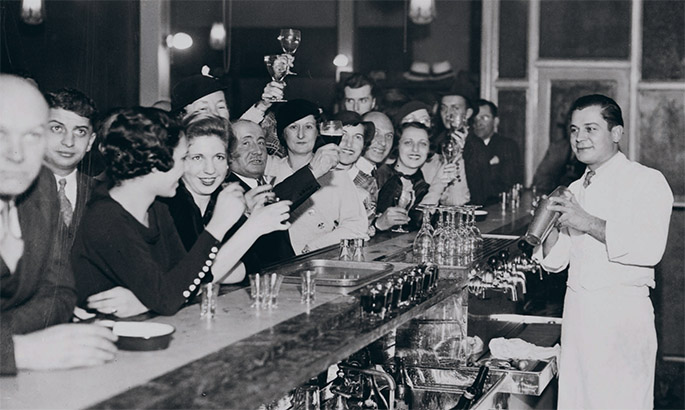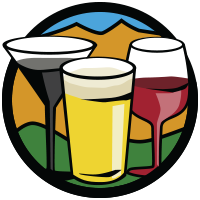As we look ahead to the New Year, we look back a bit on Colorado's history with this excerpt from our new Beer, Wine, and Spirit Drinker's Guide to Colorado. Cheers to 2015!
Colorado is a world-leading producer of beer, and the state is becoming better known for its wine and spirits, but that hasn’t always been the case.
During the Old West days, the saying here was “whiskey is for drinking and water is for fighting over.” But by 1916 the frontier was gone, Colorado was civilized and the state voted to ban alcohol, four years before the rest of the nation was swept up in the failed experiment of Prohibition.
It was a crushing blow to the family of Adolph Coors, who had been brewing beer in Golden since 1873, and to the more than 1,000 Colorado farmers growing grapes for wine. When Prohibition ended in 1933, the Coors brewery switched back from making milk and non-alcoholic beer, and by the 1970s the brewery was producing 7 million barrels a year. Coors wasn’t available on the East Coast, so it retained somewhat of a mystique.
In the meantime,Boulder was quietly becoming the national capitol of the craft beer movement. Home-brewing had been legalized in the 1970s, and Charlie Papazian, tired of the bland beers made by the handful of large companies dominating the industry, began brewing and teaching others about making craft beers. He started the American Homebrewers Association and published a book and newsletters. He put on the first Great American Beer Festival in 1982, drawing 22 small breweries to Boulder. “Relax, and have a homebrew” became the new creed, and Colorado the place to be.
Boulder Beer Co. launched in 1979, inspired by Papazian, and it remains the oldest craft brewery in Colorado. The first modern brewpub was The Wynkoop Brewing Co., opened in 1988. One of its founders, John Hickenlooper, went on to become governor of Colorado. The Great American Beer Festival went on to become the nation’s premiere beer event, drawing thousands of entries and 50,000 patrons to Denver each October. And Colorado went on to become one of the nation’s greatest states for craft brewing.
The wine and liquor industries were slower to recover. The first post-Prohibition winery opened in 1968 in the basement of a Denver dentist, and a handful more followed suit, but there were still only five licensed in 1990. Colorado Mountain Vineyards opened in 1980; called Colorado Cellars today, it is the state’s oldest still in operation. Due to efforts by the Colorado Wine Industry Development Board and the success of growing grapes in the temperate climate of the Western Slope, there were about one hundred wineries twenty years later.
In volume, Colorado is still a lightweight in wine production. In 2012 we cranked out 334,089 gallons. Total. New Mexico bottled more than twice as much wine, and California produced 2,000 times as much: 667.5 MILLION gallons in 2012. But Colorado wines aren’t plonk, winning top awards and new customers year in, year out.
Wine producers in the designated American Viticultural Areas of Grand Valley AVA (established 1991) and West Elks AVA (2001) are blessed with warm days, cool nights and a hot marketplace for lo- cal craft-made products. The burgeoning farm-to-table ethos is bringing growers, vintners, retailers, restauranteurs and consumers together, and creating new interest in Colorado-made wines.
The distilling boom is even more recent. In 1998, volunteer firefighter Jess Graber helped battle a blaze at the barn of George Stranahan, founder of Flying Dog Brewery, and the two discovered a shared passion for good whiskey. Stranahan’s Colorado Whiskey was born six years later, and it claims to be the first legal distillery here since Prohibition. Six distillers had earned their licenses by 2000. Many other distilleries have opened since to sate a growing thirst for locally-made liquor.
“Colorado-made” means something good in craft beer circles, and distillers are fortunate to be able to ride this wave of craft-made appreciation surrounding Colorado products. Locals and visitors alike will go out of their way to find good things to taste and great places to visit, and the word continues to get out: Breckenridge Distilling products are sold in 40 states and counting. Peach Street Distillers in Palisade (the state’s oldest locally-owned distiller) sells its product (made from over-ripe peaches that were originally thrown out) in Sweden.
The same lenient liquor laws allowing breweries to self-distribute apply to distillers, too, enabling them to start small, keep costs low, and grow slowly by selling directly to liquor stores, restaurants and walk-in customers. Like Colorado microbrewers, Colorado distillers share a common foe - competing not with each other but with the big mass-produced, standardized producers. As craft distillers gain momentum and market share, look for new spirit labels from new towns large and small across Colorado.

Colorado is a world-leading producer of beer, and the state is becoming better known for its wine and spirits, but that hasn’t always been the case.
During the Old West days, the saying here was “whiskey is for drinking and water is for fighting over.” But by 1916 the frontier was gone, Colorado was civilized and the state voted to ban alcohol, four years before the rest of the nation was swept up in the failed experiment of Prohibition.
It was a crushing blow to the family of Adolph Coors, who had been brewing beer in Golden since 1873, and to the more than 1,000 Colorado farmers growing grapes for wine. When Prohibition ended in 1933, the Coors brewery switched back from making milk and non-alcoholic beer, and by the 1970s the brewery was producing 7 million barrels a year. Coors wasn’t available on the East Coast, so it retained somewhat of a mystique.
In the meantime,Boulder was quietly becoming the national capitol of the craft beer movement. Home-brewing had been legalized in the 1970s, and Charlie Papazian, tired of the bland beers made by the handful of large companies dominating the industry, began brewing and teaching others about making craft beers. He started the American Homebrewers Association and published a book and newsletters. He put on the first Great American Beer Festival in 1982, drawing 22 small breweries to Boulder. “Relax, and have a homebrew” became the new creed, and Colorado the place to be.
Boulder Beer Co. launched in 1979, inspired by Papazian, and it remains the oldest craft brewery in Colorado. The first modern brewpub was The Wynkoop Brewing Co., opened in 1988. One of its founders, John Hickenlooper, went on to become governor of Colorado. The Great American Beer Festival went on to become the nation’s premiere beer event, drawing thousands of entries and 50,000 patrons to Denver each October. And Colorado went on to become one of the nation’s greatest states for craft brewing.
The wine and liquor industries were slower to recover. The first post-Prohibition winery opened in 1968 in the basement of a Denver dentist, and a handful more followed suit, but there were still only five licensed in 1990. Colorado Mountain Vineyards opened in 1980; called Colorado Cellars today, it is the state’s oldest still in operation. Due to efforts by the Colorado Wine Industry Development Board and the success of growing grapes in the temperate climate of the Western Slope, there were about one hundred wineries twenty years later.
In volume, Colorado is still a lightweight in wine production. In 2012 we cranked out 334,089 gallons. Total. New Mexico bottled more than twice as much wine, and California produced 2,000 times as much: 667.5 MILLION gallons in 2012. But Colorado wines aren’t plonk, winning top awards and new customers year in, year out.
Wine producers in the designated American Viticultural Areas of Grand Valley AVA (established 1991) and West Elks AVA (2001) are blessed with warm days, cool nights and a hot marketplace for lo- cal craft-made products. The burgeoning farm-to-table ethos is bringing growers, vintners, retailers, restauranteurs and consumers together, and creating new interest in Colorado-made wines.
The distilling boom is even more recent. In 1998, volunteer firefighter Jess Graber helped battle a blaze at the barn of George Stranahan, founder of Flying Dog Brewery, and the two discovered a shared passion for good whiskey. Stranahan’s Colorado Whiskey was born six years later, and it claims to be the first legal distillery here since Prohibition. Six distillers had earned their licenses by 2000. Many other distilleries have opened since to sate a growing thirst for locally-made liquor.
“Colorado-made” means something good in craft beer circles, and distillers are fortunate to be able to ride this wave of craft-made appreciation surrounding Colorado products. Locals and visitors alike will go out of their way to find good things to taste and great places to visit, and the word continues to get out: Breckenridge Distilling products are sold in 40 states and counting. Peach Street Distillers in Palisade (the state’s oldest locally-owned distiller) sells its product (made from over-ripe peaches that were originally thrown out) in Sweden.
The same lenient liquor laws allowing breweries to self-distribute apply to distillers, too, enabling them to start small, keep costs low, and grow slowly by selling directly to liquor stores, restaurants and walk-in customers. Like Colorado microbrewers, Colorado distillers share a common foe - competing not with each other but with the big mass-produced, standardized producers. As craft distillers gain momentum and market share, look for new spirit labels from new towns large and small across Colorado.

Library of Congress
Colorado bar patrons imbibe legally after the repeal of Prohibition.
